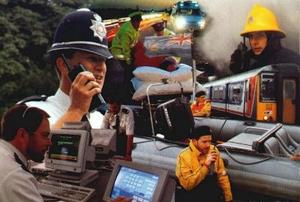First respondersHow to move forward on nationwide wireless emergency-response network
One of the lessons of 9/11 and Katrina was that there was a need for a nationwide wireless public safety and emergency-response network; trouble is, politics, arguments about spectrum allocation, business competition, and technology have all contributed to holding things up; one observer says that the way forward is for government to make a national emergency response network a wireless priority and devote dedicated, unencumbered spectrum to it

Integrated emergency communications is a worldwide challenge // Source: btinternet.co.uk
One component of the FCC’s national broadband plan includes a nationwide wireless emergency-response network. Politics, spectrum arguments, and technology, however, are holding things up.
Networkworld’s Joanie Wexler writes that a big issue is whether the D Block in the 700 MHz spectrum to be used for the network should be auctioned off to bidders. The FCC auction idea did not work the first time, probably because the spectrum winner would be required to open up its commercial D Block airwaves to responders on demand during, well, emergencies. This is a challenging business model both to sustain and technically execute.
Still, the FCC has persevered in planning follow-up auctions (see “FCC to move forward with national broadband plan,” 9 April 2010 HSNW). Then recently, Senate Commerce chairman Jay Rockefeller (D-West Virginia) announced an intention to introduce a bill to create a nationwide broadband network for first responders by giving the D Block — and control of it — directly to first responder groups. No auction. No revenue. That move has triggered a fresh wave of lobbying, statements and arguments (“Former high DHS officials, lawmakers oppose new FCC plan for public safety band,” 9 June 2010 HSNW).
Wexler notes that T-Mobile, for example, wants an auction for an opportunity to get more spectrum for partial commercial use that could help it better compete with AT&T and Verizon Wireless. The Public Safety Alliance and others argue that a network reliant on commercial carriers could break down in times of crisis when calls would flood the network.
“In the meantime, no national public safety network is being built. Am I the only one getting worried and impatient?” Wexler asks.
The FCC recommends LTE for the network — networks that have not even been deployed yet and will not be ubiquitous for years. And wireless veteran Andy Seybold writes in his Public Safety Advocate newsletter that “LTE, as it is designed today and as it is being designed for tomorrow, will not support mission-critical voice communications,” in part because it doesn’t support one-to-many and peer-to-peer communications where local responders can communicate by bypassing a wireless tower if needed.
Wexler concludes:
We need action, but we have a bit of a mess. A good start would be for government to make a national emergency response network a wireless priority and devote dedicated, unencumbered spectrum to it. It’s been nearly nine years since 9/11 and five since Katrina, yet the national broadband plan doesn’t see the public safety network going live until 2020. Perhaps an interim plan will emerge for a national first-responder network. Otherwise, we better hope we don’t upset our enemies or the weather gods for the next 10 years.
